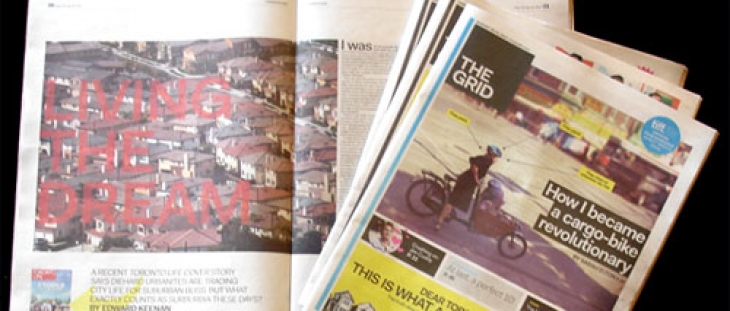
 There’s something very familiar about Toronto Life’s cover story this month, “Exodus to the burbs”, (excerpted here, but not fully online) and it makes me think that the newest threshold of sensationalism in print journalism may be the intentional vilification of stories by their editors. When the latest issue came to the door a couple of days ago, I figured I’d probably give the cover story a miss. Presumably well-off people moving from the city to the suburbs didn’t seem that new or that interesting. And, to be clear, it’s not. There is nothing new in people who at various points have been called well-off or upwardly mobile or simply middle class deciding to turn inwards towards their families and away from the ululating social scene that drew them to the city in their youth. Writing a new story about the phenomenon is a little like this Far Side comic I remember getting stuck on my door in college when I started making my speeches about how really good, like, literarily good, Hill Street Blues was. It’s got two gorillas talking to each other over a banana. “You know, Sid, I really like bananas…. I mean, I know that’s not profound or nothin’…. Heck! We all do…. But for me, I think it goes beyond that.” But then I started seeing references to it on the social streams, and by the time I read Ed Keenan’s response to it in The Grid, I realized where that sense of familiarity was coming from. Ed hadn’t done any difficult work on taking the piece apart. He did it well, but it was simple common sense. The cover and various bits of display copy related to the piece talked about urban-suburban contrasts, always favouring the latter, in a way that seemed counterintuitive to an urban magazine. Toronto Life comes out in favour of the burbs? That would be interesting. But of course they didn’t. The writer, Philip Preville, a former blogger for the magazine who recently moved to Peterborough, was actually writing about other, smaller, nearby cities like his new hometown (founded roughly 1825), Uxbridge (surveyed in 1805) and Creemore (settled 1827). The story was actually about well-heeled Torontonians discovering the charms of small-town living. There was a starker-than-average contrast between the words the writer wrote (or at least the ones the editor edited), and the way the piece was presented that recalled something the Grid had done a month or so earlier with their Beyond Gay cover, in which the editors transformed a personal essay into a statement of a Zeitgeist. This one, too, is a personal essay, and though it’s much better done than the Grid piece, the evidence is once again anecdotal, spare and drawn from the author’s own sphere (at least mostly white, with one high-earning spouse, all with kids). Even the stats he provides, about more people moving out of Toronto than move in from neighbouring municipalities, wasn’t specific enough to make any very clear case. So both fit into the well-known journalistic category of the expansion of one reporter’s experience into a trend or phenomenon. But the thing that makes me think there’s more to this is just how weak both articles are when presented as big cover stories. Both would have made fine statements of personal experience: one man’s stand against received wisdom or community standards. But just as the gay story creaked under the obviousness of its author’s and interview subjects’ lack of introspection, Preville’s, too, gets thinnest when deploying evidence to make the case that moving out of the big the city into little cities is a good idea for any reasons other than the reasons people have always given for moving out of cities. That cities are unfriendly, for instance (didn’t he ever watch Sesame Street?), or that Jane Jacobs, in the memorable phrasing of the display copy surrounding the story, should be screwed. Both Keenan and John Lorinc poke the obvious holes in the piece, but what I’m most interested in is the fact that the two pieces’ editors would also have been aware of these holes. It happens that I know a good number of the editors in question here; I’ve employed some of them in the past, and some of them have employed me. Not all editors are smart, but these ones are. They would have seen what Lorinc and Keenan saw, and in Keenan’s case, he almost certainly did see the Beyond Gay piece before it went to press. And yet these stories not only ran, they were pumped up into cover stories. Cover stories occupy a special place in the printed realm. Covers are publications’ biggest advertisements. They have to get hands on pages and eyes on screens. Now, I’m not sure if you’re on Facebook, or have a Twitter account, or in fact have ever read a comment thread underneath stories in the papers and blogs that are still foolish enough to run them unmonitored. But if you have, you’ll have noticed that people tend to like to talk about things they don’t like more than things they do. This cannot have escaped the attention of the editors we’re talking about here. After their own kick at the vilification post resulted in huge response, including the rare and doubtful honour of having their cover spoofed by another magazine, The Grid hopped on the wagon early this time around, putting a piece on their cover today referring to the meme breeze that Keenan’s piece whipped up on Twitter. The more I pay attention to newspapers and magazines and TV and online news, the more I get the sense that sensationalism in one form or another is the most important issue these media are facing today. It’s increasingly difficult to get heard, and it seems that more people are paying attention to fewer things. Tricks need to be tried, new strategies need to be rolled out if the folks who have been doing this for generations are going to have anything to hand over to the current generation of hopeful interns. I want to make it clear that I don’t think these stories are complete props, bait for a switch. Preville’s required hard work, and offered a fascinating look into the preoccupations and motivational requirements of an important demographic (or at least a half dozen members of it). But because they are smart, and because they need readers, and because this is self-evidently an at-least-sometimes-effective way to drive them, let’s assume they did. Is setting a feature up to be pilloried a good idea? The Grid probably has some figures already for their Beyond Gay issue, and Toronto Life will soon get evidence in various forms about whether their suburban gambit worked. But the only way we’ll likely know if it worked from a pick-up and click-through standpoint is if we start to see it happen more often.
There’s something very familiar about Toronto Life’s cover story this month, “Exodus to the burbs”, (excerpted here, but not fully online) and it makes me think that the newest threshold of sensationalism in print journalism may be the intentional vilification of stories by their editors. When the latest issue came to the door a couple of days ago, I figured I’d probably give the cover story a miss. Presumably well-off people moving from the city to the suburbs didn’t seem that new or that interesting. And, to be clear, it’s not. There is nothing new in people who at various points have been called well-off or upwardly mobile or simply middle class deciding to turn inwards towards their families and away from the ululating social scene that drew them to the city in their youth. Writing a new story about the phenomenon is a little like this Far Side comic I remember getting stuck on my door in college when I started making my speeches about how really good, like, literarily good, Hill Street Blues was. It’s got two gorillas talking to each other over a banana. “You know, Sid, I really like bananas…. I mean, I know that’s not profound or nothin’…. Heck! We all do…. But for me, I think it goes beyond that.” But then I started seeing references to it on the social streams, and by the time I read Ed Keenan’s response to it in The Grid, I realized where that sense of familiarity was coming from. Ed hadn’t done any difficult work on taking the piece apart. He did it well, but it was simple common sense. The cover and various bits of display copy related to the piece talked about urban-suburban contrasts, always favouring the latter, in a way that seemed counterintuitive to an urban magazine. Toronto Life comes out in favour of the burbs? That would be interesting. But of course they didn’t. The writer, Philip Preville, a former blogger for the magazine who recently moved to Peterborough, was actually writing about other, smaller, nearby cities like his new hometown (founded roughly 1825), Uxbridge (surveyed in 1805) and Creemore (settled 1827). The story was actually about well-heeled Torontonians discovering the charms of small-town living. There was a starker-than-average contrast between the words the writer wrote (or at least the ones the editor edited), and the way the piece was presented that recalled something the Grid had done a month or so earlier with their Beyond Gay cover, in which the editors transformed a personal essay into a statement of a Zeitgeist. This one, too, is a personal essay, and though it’s much better done than the Grid piece, the evidence is once again anecdotal, spare and drawn from the author’s own sphere (at least mostly white, with one high-earning spouse, all with kids). Even the stats he provides, about more people moving out of Toronto than move in from neighbouring municipalities, wasn’t specific enough to make any very clear case. So both fit into the well-known journalistic category of the expansion of one reporter’s experience into a trend or phenomenon. But the thing that makes me think there’s more to this is just how weak both articles are when presented as big cover stories. Both would have made fine statements of personal experience: one man’s stand against received wisdom or community standards. But just as the gay story creaked under the obviousness of its author’s and interview subjects’ lack of introspection, Preville’s, too, gets thinnest when deploying evidence to make the case that moving out of the big the city into little cities is a good idea for any reasons other than the reasons people have always given for moving out of cities. That cities are unfriendly, for instance (didn’t he ever watch Sesame Street?), or that Jane Jacobs, in the memorable phrasing of the display copy surrounding the story, should be screwed. Both Keenan and John Lorinc poke the obvious holes in the piece, but what I’m most interested in is the fact that the two pieces’ editors would also have been aware of these holes. It happens that I know a good number of the editors in question here; I’ve employed some of them in the past, and some of them have employed me. Not all editors are smart, but these ones are. They would have seen what Lorinc and Keenan saw, and in Keenan’s case, he almost certainly did see the Beyond Gay piece before it went to press. And yet these stories not only ran, they were pumped up into cover stories. Cover stories occupy a special place in the printed realm. Covers are publications’ biggest advertisements. They have to get hands on pages and eyes on screens. Now, I’m not sure if you’re on Facebook, or have a Twitter account, or in fact have ever read a comment thread underneath stories in the papers and blogs that are still foolish enough to run them unmonitored. But if you have, you’ll have noticed that people tend to like to talk about things they don’t like more than things they do. This cannot have escaped the attention of the editors we’re talking about here. After their own kick at the vilification post resulted in huge response, including the rare and doubtful honour of having their cover spoofed by another magazine, The Grid hopped on the wagon early this time around, putting a piece on their cover today referring to the meme breeze that Keenan’s piece whipped up on Twitter. The more I pay attention to newspapers and magazines and TV and online news, the more I get the sense that sensationalism in one form or another is the most important issue these media are facing today. It’s increasingly difficult to get heard, and it seems that more people are paying attention to fewer things. Tricks need to be tried, new strategies need to be rolled out if the folks who have been doing this for generations are going to have anything to hand over to the current generation of hopeful interns. I want to make it clear that I don’t think these stories are complete props, bait for a switch. Preville’s required hard work, and offered a fascinating look into the preoccupations and motivational requirements of an important demographic (or at least a half dozen members of it). But because they are smart, and because they need readers, and because this is self-evidently an at-least-sometimes-effective way to drive them, let’s assume they did. Is setting a feature up to be pilloried a good idea? The Grid probably has some figures already for their Beyond Gay issue, and Toronto Life will soon get evidence in various forms about whether their suburban gambit worked. But the only way we’ll likely know if it worked from a pick-up and click-through standpoint is if we start to see it happen more often.














